Note: Some readers requested for the Coolpad Cool 1 to be included in this comparison. In an earlier version of this article, we had left that phone out. This was done because the Cool 1 wasn't immediately available at the time this was written. However, we have tested the Cool 1 and have included all its benchmark scores in the article, barring the gaming frame rates, which can't be obtained right now, since we don't have the phone handy.
The budget range has once again come alive. This time with Lenovo's introduction of the Moto G5 Plus. We already established that the phone has the best camera in its price bracket, but that doesn't cover everything, does it? Other budget devices, like the Honor 6XWhere to buy 12999 and Xiaomi Redmi Note 4 are substantially cheaper than the Moto G5 Plus. Is its camera enough to make up for the added cost, then?
12999 and Xiaomi Redmi Note 4 are substantially cheaper than the Moto G5 Plus. Is its camera enough to make up for the added cost, then?
For the record, we do not recommend buying 16GB smartphones, so despite its impressive camera, we wouldn't suggest buying the 16GB variant of the Moto G5 PlusWhere to buy 16999.
16999.
Speed and Fluidity
Testing the phones side by side, the Honor 6XWhere to buy 12999 quickly falls behind. In day-to-day usage, the Honor 6X shows very noticeable lags in simple UI animations and transitions. This, though, is absent from both the Redmi Note 4 and Moto G5 PlusWhere to buy
12999 quickly falls behind. In day-to-day usage, the Honor 6X shows very noticeable lags in simple UI animations and transitions. This, though, is absent from both the Redmi Note 4 and Moto G5 PlusWhere to buy 16999 (review). Huawei's Kirin 655 doesn't seem to match up to the Snapdragon 625 powering the other two phones here.
16999 (review). Huawei's Kirin 655 doesn't seem to match up to the Snapdragon 625 powering the other two phones here.
There's very little separating the Redmi Note 4 and Moto G5 PlusWhere to buy 16999, however. The two phones are impressively fluid in regular usage, and app load times are kept to a minimum. The Redmi Note 4 is just slightly snappier than the Moto G5 Plus in this case, thanks to higher clock speeds. To be clear, both phones have the Snapdragon 625 clocked at 2GHz. However, Xiaomi seems to allow higher average clock speeds than the G5 Plus.
16999, however. The two phones are impressively fluid in regular usage, and app load times are kept to a minimum. The Redmi Note 4 is just slightly snappier than the Moto G5 Plus in this case, thanks to higher clock speeds. To be clear, both phones have the Snapdragon 625 clocked at 2GHz. However, Xiaomi seems to allow higher average clock speeds than the G5 Plus.
On the other hand, the extra Cortex A72 cores on the Snapdragon 652 running on the Coolpad Cool 1 (review), give it extra speed over the other devices. Benchmarks obviously put the Cool 1 ahead of the other devices in this comparison, but the more powerful Cortex A72 cores make the SoC less power efficient. That said, the Cool 1 remains the most powerful amongst all these devices at the moment. However, this difference is difficult to spot in regular usage.
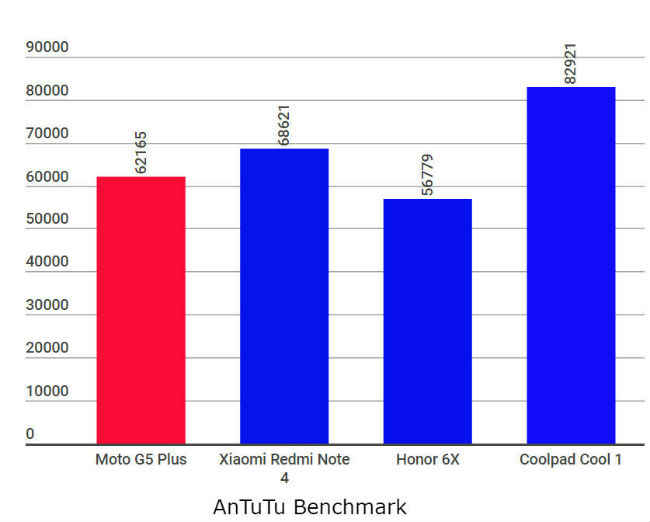
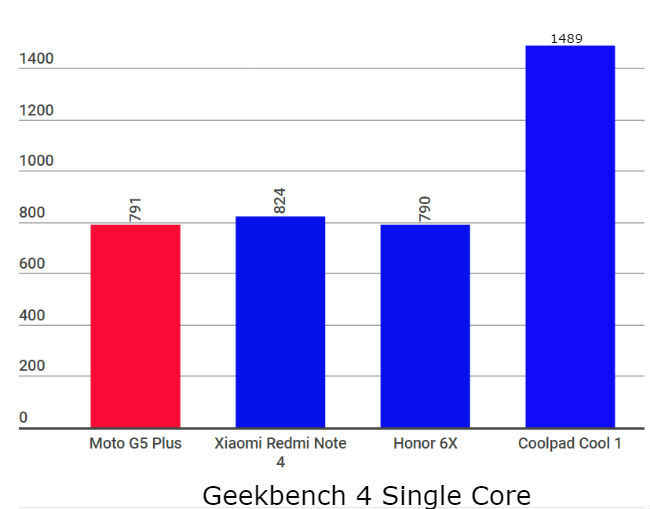
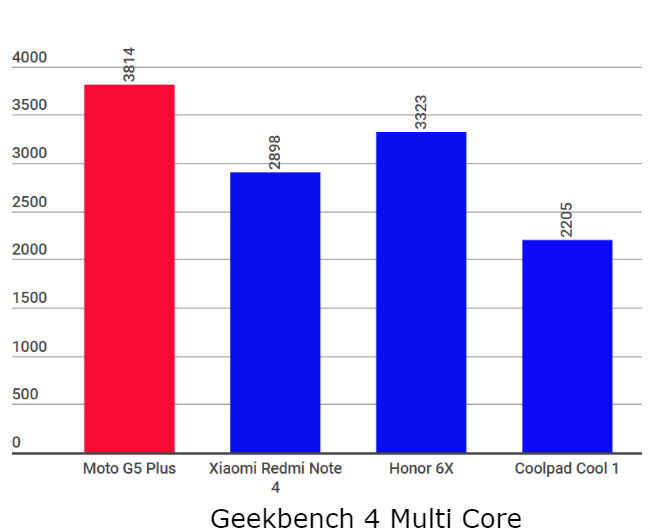
Qualcomm's Trepn Profiles shows the eight cores on the Redmi Note 4, clocking between 1.7GHz and 2GHz at most times. The G5 PlusWhere to buy 16999, however, keeps them somewhat subdued, between 1.5GHz and 1.7GHz, until you launch games or other heavy apps. As a result, the Mi device is only slightly faster in regular usage, but it's tough to point out the difference without side-by-side comparison.
16999, however, keeps them somewhat subdued, between 1.5GHz and 1.7GHz, until you launch games or other heavy apps. As a result, the Mi device is only slightly faster in regular usage, but it's tough to point out the difference without side-by-side comparison.
Strictly speaking, the Xiaomi Redmi Note 4 is the fastest of the lot, followed by the Moto G5 PlusWhere to buy 16999 and then the Honor 6XWhere to buy
16999 and then the Honor 6XWhere to buy 12999 (review). The Kirin 655 uses the big.LITTLE mechanism, two quad-core Cortex A53 clusters, clocked at 2.1GHz and 1.7GHz respectively. The lower clocked cores often clock down to as low as 400 MHz, while the higher cores revolve between 1.4-2.1GHz. While the lower clock speeds could be a trade-off for higher battery life, they could also be the reason why UI elements show lags at times.
12999 (review). The Kirin 655 uses the big.LITTLE mechanism, two quad-core Cortex A53 clusters, clocked at 2.1GHz and 1.7GHz respectively. The lower clocked cores often clock down to as low as 400 MHz, while the higher cores revolve between 1.4-2.1GHz. While the lower clock speeds could be a trade-off for higher battery life, they could also be the reason why UI elements show lags at times.
Gaming
To test gaming on the devices, we used Asphalt 8, with half an hour gaming sessions on each device. The objective was to establish which phone managed the highest frame rates, and with the maximum stability. For reference, the Adreno 506 GPU runs on the Motorola and Xiaomi phones, while the Mali T830MP2 GPU runs on the Huawei device.
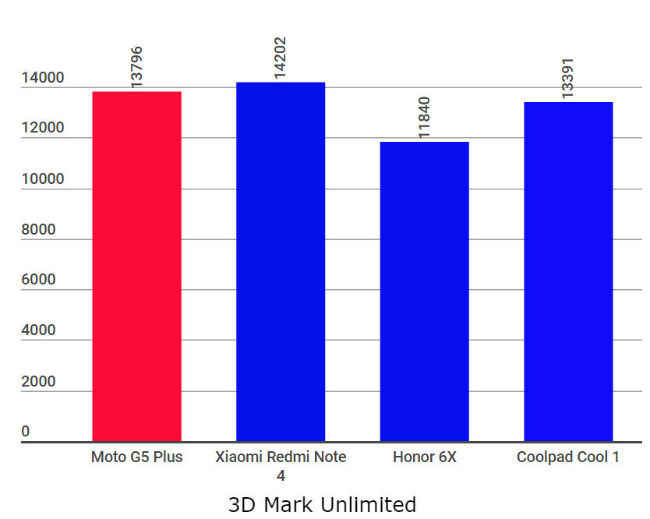
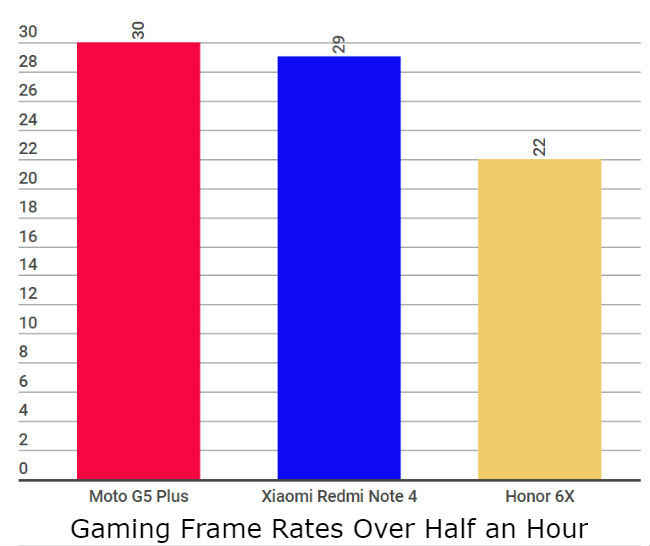
Testing using Gamebench, which gives you real time frame rates, we found the the Honor 6XWhere to buy 12999 is behind in this case as well. The former dropped to as low as 17 fps whi le playing Asphalt 8, while frame rate stability was only 71%. It also achieved best frame rates of about 22fps, which is significantly lower than you would want. As a result, one can see definite stutters while playing Asphalt 8, or during its menu and in-game transitions.
12999 is behind in this case as well. The former dropped to as low as 17 fps whi le playing Asphalt 8, while frame rate stability was only 71%. It also achieved best frame rates of about 22fps, which is significantly lower than you would want. As a result, one can see definite stutters while playing Asphalt 8, or during its menu and in-game transitions.
On the other hand, while the two Adreno powered phones were ahead, the Moto G5 PlusWhere to buy 16999 came out ahead of the Redmi Note 4 (review) here, by a hair. The Motorola phone achieves stable frame rates of 30fps over half an hour, with 80% frame rate stability, whereas the Redmi Note 4 caps frame rates at 29fps, with the same stability. This, as you probably know, is the bare minimum for stutter free gaming, and bot h phones fare well in this case.
16999 came out ahead of the Redmi Note 4 (review) here, by a hair. The Motorola phone achieves stable frame rates of 30fps over half an hour, with 80% frame rate stability, whereas the Redmi Note 4 caps frame rates at 29fps, with the same stability. This, as you probably know, is the bare minimum for stutter free gaming, and bot h phones fare well in this case.
Temperatures
Internal temperatures on all the phones remain around 36 degrees celsius at most times. Impressively, both the Moto G5 PlusWhere to buy 16999 and Redmi Note 4 managed the same when we were gaming on it. The Honor 6XWhere to buy
16999 and Redmi Note 4 managed the same when we were gaming on it. The Honor 6XWhere to buy 12999 kept stable temperatures of 39 degrees here, rising to 40 degrees for a few seconds.
12999 kept stable temperatures of 39 degrees here, rising to 40 degrees for a few seconds.
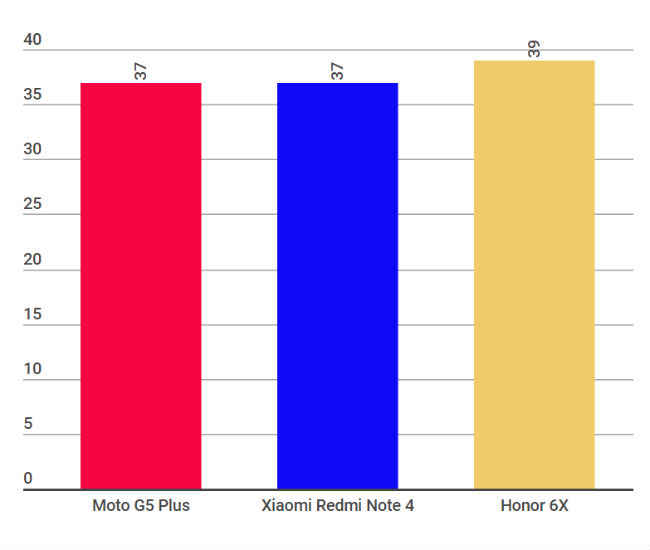
All three phones, though, remained within permissible limits, not raising any alarms worth talking about. They cool down fast, too, making it easier to manage after a long gaming session.
Battery Life
In terms of specs, the Moto G5 PlusWhere to buy 16999 comes in last here. The phone has a 3000 mAh battery against the 3340 mAh unit on the Honor 6XWhere to buy
16999 comes in last here. The phone has a 3000 mAh battery against the 3340 mAh unit on the Honor 6XWhere to buy 12999, 4100 mAh on the Redmi Note 4 and 4060 mAh battery on the Cool 1. Brute forcing the battery, with PC Mark's Work 2.0 battery test, the Redmi Note 4 comes out in front. It lasts 8 hours and 55 minutes, against the Moto G5 Plus' 7 hours and 29 minutes, Honor 6X's 5 hours 19 minutes, and the Cool 1's 6 hours 24 minutes. It's actually quite surprising that the Honor 6X falls behind the Cool 1 in this test, since the latter's faster processor should ideally drain more power. Regardless, it's possible that Coolpad's optimisations are slightly better than Honor's.
12999, 4100 mAh on the Redmi Note 4 and 4060 mAh battery on the Cool 1. Brute forcing the battery, with PC Mark's Work 2.0 battery test, the Redmi Note 4 comes out in front. It lasts 8 hours and 55 minutes, against the Moto G5 Plus' 7 hours and 29 minutes, Honor 6X's 5 hours 19 minutes, and the Cool 1's 6 hours 24 minutes. It's actually quite surprising that the Honor 6X falls behind the Cool 1 in this test, since the latter's faster processor should ideally drain more power. Regardless, it's possible that Coolpad's optimisations are slightly better than Honor's.
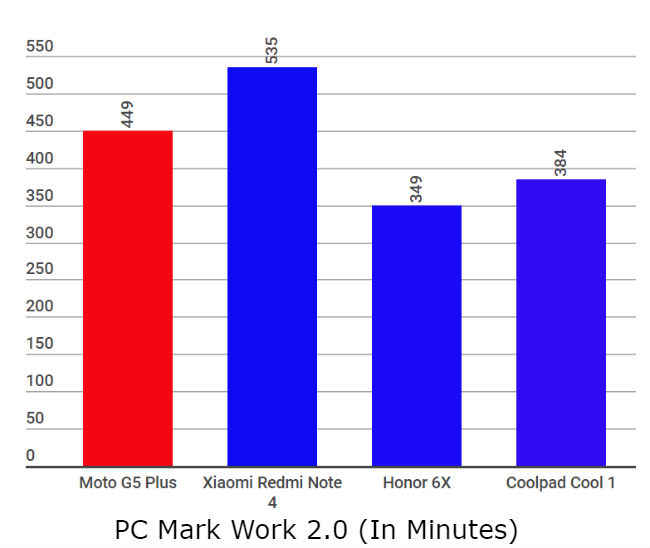
Benchmarks aside, all these phones can get you through over 10 hours easily. The Redmi Note 4 and Moto G5 PlusWhere to buy 16999 can go nearly up to 24 hours, give or take an hour. The Honor 6XWhere to buy
16999 can go nearly up to 24 hours, give or take an hour. The Honor 6XWhere to buy 12999 will last through your work-day with a single charge, but it will need an extra half an hour or so's charge, to last a full 24 hours. The same applies for the Cool 1, which returned 12 hours battery life in regular usage, spread over 4G and WiFi.
12999 will last through your work-day with a single charge, but it will need an extra half an hour or so's charge, to last a full 24 hours. The same applies for the Cool 1, which returned 12 hours battery life in regular usage, spread over 4G and WiFi.
Bottomline
The Xiaomi Redmi Note 4 and Moto G5 PlusWhere to buy 16999 are evenly matched in terms of performance. Both phones are fast, snappy and well tuned. However, the G5 Plus' camera does make it a better buy than the Redmi Note 4. To camera enthusiasts, the Moto G5 Plus would make more sense. However, the Moto G5 Plus makes sense for those who want a balanced smartphone as well. The choice basically comes down to whether you're willing to pay nearly Rs. 5000 more for the advanced camera on the G5 Plus.
16999 are evenly matched in terms of performance. Both phones are fast, snappy and well tuned. However, the G5 Plus' camera does make it a better buy than the Redmi Note 4. To camera enthusiasts, the Moto G5 Plus would make more sense. However, the Moto G5 Plus makes sense for those who want a balanced smartphone as well. The choice basically comes down to whether you're willing to pay nearly Rs. 5000 more for the advanced camera on the G5 Plus.
For those who want performance over everything else, the Coolpad Cool 1 is the phone to pick, and it has a pretty good camera as well. However, there is a slight compromise here, on battery life. It is also worth noting that the Redmi Note 4 and Honor 6XWhere to buy 12999 are the cheapest of these devices, and while the Honor 6X has a really good camera (better than the Cool 1), while the Redmi Note 4 is a balance smartphone, offering something of everything.
12999 are the cheapest of these devices, and while the Honor 6X has a really good camera (better than the Cool 1), while the Redmi Note 4 is a balance smartphone, offering something of everything.
For those asking, we do not recommend buying the 16GB variant of the Moto G5 PlusWhere to buy 16999. In fact, we do not recommend buying 16GB smartphones at all, in this day and age. Images shot by the Moto G5 Plus are 4MB and above often, and with only about 12GB of usable space, you will run out easily.
16999. In fact, we do not recommend buying 16GB smartphones at all, in this day and age. Images shot by the Moto G5 Plus are 4MB and above often, and with only about 12GB of usable space, you will run out easily.


No comments:
Post a Comment